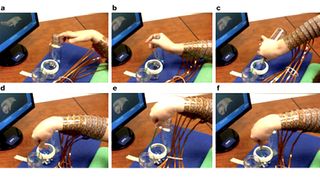This tech just let a paralyzed man move his fingers again
Technology restores man's ability to pinch, grab and play video games

A brain implant has restored new functionality in a paralyzed man, restoring partial use of his hand and putting researchers one step forward in potentially one day curing paralysis.
Ian Burkhart regained the dexterity needed to pour a bottle, swipe a credit card, and play a simplified Guitar Hero-style rhythm game using his previously immobilized hand – all firsts for the 24-year-old since a spinal cord injury rendered him quadriplegic six years ago.
The device is a combination of a computer chip implanted in Burkhart's brain and a cuff lined with electrodes that individually stimulate muscles in the hand.
The implanted chip reads and interprets the electric impulses the body normally responds to and passes the signals down the arm, circumventing the usual neurological channels are damaged, blocked, or unresponsive as a result of a paralyzing injury or condition.
The system is a collaboration between technology firm Battelle's Neural Bypass Technology and medical researchers at Ohio State University. According to the team's published report, this is the first time a paralyzed human has been able to control their muscles using "intracortically recorded signals", a tricky-to-pronounce term that means that the signals were created originally in the patient's own brain.
While similar technology has been used to create functional bionic limbs and eyes, researchers believe Burkhart's implant in particular is the first case of successfully bridging signals from the brain through a machine back to another part of the body.
A breakthrough, but no cure
While this is certainly a breakthrough in its own right, the cure for paralysis has many more hurdles still ahead.
Get daily insight, inspiration and deals in your inbox
Get the hottest deals available in your inbox plus news, reviews, opinion, analysis and more from the TechRadar team.
For starters, the tech that enables Burkhart to grasp objects once more is cumbersome to implement – the signals received from the host have to run through an external computer, ruling out any portable use for the time being.
On top of that, the implant sports less than 100 electrodes to coordinate muscles contractions, meaning that certain actions – like typing or playing more complex chords in Guitar Hero, let alone on a real guitar – would require far more precise equipment.
The researchers told The Verge they want to increase the electrode count to "a couple thousand" as they continue to improve upon the tech and march just a few steps closer to the team's ultimate goal of restoring mobility to the immobile, and giving hope to those afflicted by paralysis.
Top image credit: Nature
Everything we know about the Nintendo NX

